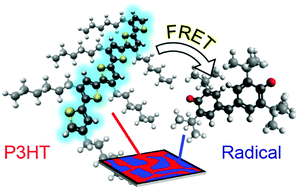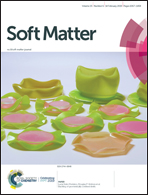Tuning the interfacial and energetic interactions between a photoexcited conjugated polymer and open-shell small molecules†
Abstract
Design rules and application spaces for closed-shell conjugated polymers have been well established in the field of organic electronics, but the emerging class of open-shell stable radicals has not been evaluated in such detail. Thus, establishing the underlying physical phenomena associated with the interactions between both classes of molecules is imperative for the effective utilization of these soft materials. Here, we establish that Förster Resonance Energy Transfer (FRET) is the dominant mechanism by which energy transfer occurs from a common conjugated polymer to various radical species using a combination of experimental and computational approaches. Specifically, we determined this fact by monitoring the fluorescence quenching of poly(3-hexylthiophene) (P3HT) in the presence of three radical species: (1) the galvinoxyl; (2) the 2-phenyl-4,4,5,5-tetramethylimidazoline-3-oxide-1-oxyl (PTIO); and (3) the 4-hydroxy-2,2,6,6-tetramethylpiperidine-1-oxyl (TEMPO) radicals. Both in solution and in the solid-state, the galvinoxyl and PTIO radicals showed quenching that was on par with that of a common fullerene electron-accepting derivative, due to the considerable overlap of their absorbance spectrum with the fluorescence spectrum of the P3HT species, which indicated that isoenergetic electronic transitions existed for both species. Conversely, TEMPO showed minimal quenching at similar concentrations due to the lack of such an overlap. Furthermore, computational studies demonstrated that FRET would occur at a significantly faster rate than other competing processes. These findings suggest that long-range energy transfer can be accomplished in applications when radicals that can act as FRET acceptors are utilized, forming a new design paradigm for future applications involving both closed- and open-shell soft materials.

- This article is part of the themed collection: Soft Matter Emerging Investigators


 Please wait while we load your content...
Please wait while we load your content...